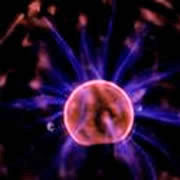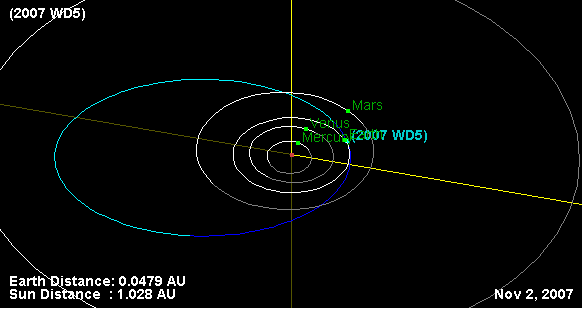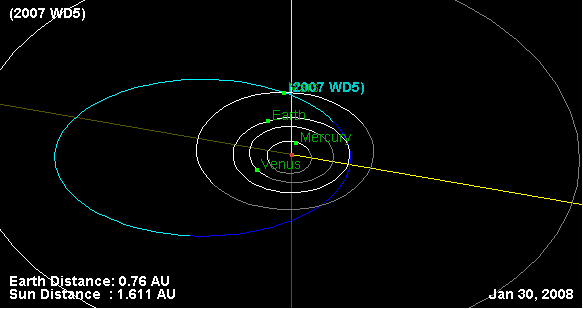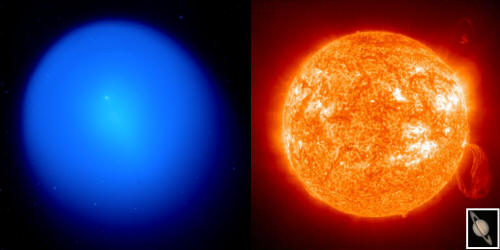|
|
|
Spanish version
On December 28, 2007, scientists from the Near Earth Object Program (NASA/JPL) released their latest estimate on the projected flight path of an asteroid (2007-WD5) that had been earlier predicted to hit Mars with odds of 1 in 25.
The final estimate is that on January 9, the 50 meter asteroid will miss Mars by approximately 4000 kilometers, a near miss in astronomical terms.
Hopes that scientists would learn more
about conditions on Mars and the consequences of a similar asteroid
impact on Earth were dashed with the January 9 announcement. The
scientific community therefore expects the asteroid to have its
Martian rendezvous with nothing out of the ordinary occurring.
However, while the asteroid will closely miss Mars, according to an astronomical model called 'Plasma Cosmology', there is likely to be a very significant "plasma discharge" between Mars and the asteroid.
The plasma discharge will light Mars up
in a stunning way as the asteroid discharges with Mars, the positive
electrical charge it gained from its closest approach to Earth on
November 2, 2007. This means that the asteroid (carrying a positive
charge relative to Mars) and Mars (carrying a negative charge
relative to the asteroid) will for a short period form a giant
celestial capacitor that discharges.
So it can be predicted that Mars, after it absorbs a plasma discharge from the passing asteroid 2007-WD5, will for a period become a red sun. This makes the expected rendezvous of Mars and the asteroid far more significant than a mere close miss as suggested by the standard cosmological model.
The flyby raises the intriguing possibility that a red sun emerging from the plasma discharge between Mars and asteroid may be a fulfillment of Hopi Indian prophecies concerning the appearance of the Red Kachina.
First, some background information will
be helpful.
Charges flow through this electric field by virtue of the plasma particles that are constantly being released by the sun (aka solar wind ).
Plasma is the fourth state of matter (solid, liquid, and gas being the first three) and comprises the free protons, neutrons, electrons and ions that make up neutral atoms. Importantly, plasma makes up approximately 99.999% of the visible universe so its behavior is increasingly an area of scientific interest.
Plasma is not electrically neutral, but is a
superconductor that can carry electrical charges throughout the
solar system (and indeed into interstellar and intergalactic space)
through what are known as
Birkeland currents.
In between, the electric field of the sun and the Birkeland currents flowing from it through space, provide positive charges to planets, asteroids and comets depending on the nature of their orbits and proximity to one another.
Plasma discharges (see right image)
therefore regularly occur with celestial bodies.
When a comet or asteroid moves close to a planet or the sun on an elliptical orbit, its electrical charge is significantly different in that region of the solar system's electrical field. The accumulation of charge and/or a plasma discharge subsequently occurs.
For example, when comets travel close to the sun, plasma discharges (aka Coronal Mass Ejections - CME) have been observed to occur.
Most astronomers are puzzled by such events which
they currently regard as mere coincidence. For supporters of plasma
cosmology, however, the sun's behavior when comet's approach is
evidence of the plasma discharge
that regularly occurs when two charged celestial bodies approach
each other.
This is exactly what happened
thereby giving powerful support to
the plasma cosmology model.
The asteroid normally orbits in a region between Earth and Jupiter (see the following two diagrams depicting its orbit). So it would accumulate or discharge plasma depending on the region of space it is traveling through, and the Birkeland currents it encounters.
However, when asteroids approach planets, they may accumulate a positive charge from a planet closer to the sun, and undergo a plasma discharge as it passes close by a more distant planet.
This is exactly what is likely to happen with asteroid 2007-WD5.
On November 2, 2007, the asteroid did a relatively close flyby of the Earth as seen in the diagram (on left) where 2007 WD5 is superimposed over Earth.
It was only 0.0479AU
(approximately 7 million Km.) from Earth. This is close enough for
the asteroid to be positively charged by the Earth's magnetosphere.
Charged in this way, the asteroid is now carrying an abundance of
positively charged ions, relative to Mars, as it races towards it
for its January 30 2008 Martian rendezvous.
Put simply, for a short period of time, Mars and the asteroid will form a giant celestial capacitor that discharges causing them both to light up in a fashion resembling a second sun.
Given that Mars and Earth are relatively close in their respective orbits on January 30 (see diagram below), the plasma exchange between Mars and the asteroid will be very visible in the night sky, and will have a distinctive red hue to it.
While the plasma discharge between Mars and the asteroid will certainly be a rare celestial event, what makes it even more intriguing is that rumors have begun circulating the internet that over the next few weeks, a second sun will mysteriously appear in the sky.
The likelihood that a plasma discharge between the asteroid and Mars will light Mars up spectacularly raises the possibility that it could be the second sun alluded to in such predictions.
In fact, if the plasma cosmology model is correct, it can be predicted that Mars will light up as a (red) second sun on or around January 30, 2008.
On October 24, 2007 Comet 17P/Holmes lit up in a spectacular way.
The coma of the relatively small comet with a core of several kilometers, grow in size to be larger than the sun (diagram above shows Holmes and the sun compared with Saturn). Its spectacular increase thrilled sky watchers for over a month as it formed a faint blue sun in the night sky.
Comet Holmes' expansion was a mystery, according to most astronomers.
In the plasma cosmology model, Comet Holmes expansion was due to a plasma discharge as it entered a region of space where the charges accumulated by the comet in its orbit discharged. The plasma discharge appeared to happen when the Comet passed through the magnetosphere of Mars causing its spectacular expansion.
Such an event is likely to repeat itself as the asteroid experiences a close rendezvous with Mars.
The smaller size of the asteroid, when compared to Comet Holmes, makes it an unlikely candidate for the coma expansion experienced by Comet Holmes. However, that is not so for Mars which has sufficient mass to undergo a spectacular plasma discharge and coma expansion that replicates what occurred with Comet Holmes.
Consequently, it is predicted that Mars will undergo a spectacular expansion on or soon after the January 30 rendezvous.
So this coming event may qualify as the
mysterious second sun prediction.
This raises the intriguing question of whether the January 30 asteroid rendezvous with Mars could signify the coming of the fabled Red Kachina in Hopi Indian prophesy.
This follows earlier speculation that
Comet Holmes formed the Blue Kachina, and its appearance in 2007
was predicted by crop circles created in 2005.
The Red Kachina signifies the time of purification when humanity faces a series of fundamental choices in its evolution.
Successful choices will lead to a harmonious transition from the 4th world (which refers to current Western civilization) to the 5th world which represents a new world based on truth, justice, peace and harmony.
The prediction of Comet Holmes/Blue Kachina by crop circles discovered in 2005 raises the intriguing questions of who made them, and is there any relationship with Mars possibly lighting up on January 30, 2008?
According, to the Hopi, the transition from the fourth to fifth world will herald the return of the "brothers from the Stars."
Are extraterrestrials responsible for
making the crop circles, and therefore drawing humanity's attention
to celestial events that portend widespread planetary changes?
The possible lighting up of the red planet, Mars, due to a plasma discharge caused by asteroid 2007-WD5 may signify nothing more than a very rare celestial event. At the very least this will give powerful evidentiary support for the Plasma Cosmology model that currently is largely dismissed by the mainstream astronomical community.
There may, however, be more to Mars briefly becoming a red sun than simply demonstrating the validity of plasma discharge predictions concerning celestial bodies. The formation of a red sun may well signify the Red Kachina as foretold in Hopi prophesy.
Such prophesy alerts us to celestial events that herald a time of rapid planetary transition.
We can look forward to whatever happens on January 30 as the start of a fascinating journey for humanity as it seriously ponders the confluence of a rare celestial event, Native American prophecies, crop circles and exopolitics.
|


 Put
simply, the sun forms a giant anode where positive charges are most
abundant (due to Birkeland currents from the galactic core) while
the distant ends of the solar system form the most negatively
charged regions of the solar system (cathode).
Put
simply, the sun forms a giant anode where positive charges are most
abundant (due to Birkeland currents from the galactic core) while
the distant ends of the solar system form the most negatively
charged regions of the solar system (cathode). 

